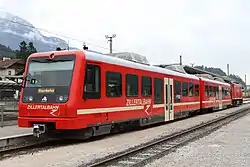Zillertal Railway
The Zillertal Railway or Zillertalbahn is a 760 mm (2 ft 5 15⁄16 in) gauge independent railway running along the valley of the river Ziller (Zillertal) from Jenbach to Mayrhofen within the Tyrol area of Austria and is nearly 32 km (20 miles) long.
| Zillertal Railway | |||||||||||||||||||||||||||||||||||||||||||||||||||||||||||||||||||||||||||||||||||||||||||||||
|---|---|---|---|---|---|---|---|---|---|---|---|---|---|---|---|---|---|---|---|---|---|---|---|---|---|---|---|---|---|---|---|---|---|---|---|---|---|---|---|---|---|---|---|---|---|---|---|---|---|---|---|---|---|---|---|---|---|---|---|---|---|---|---|---|---|---|---|---|---|---|---|---|---|---|---|---|---|---|---|---|---|---|---|---|---|---|---|---|---|---|---|---|---|---|---|
 Low-floor train at Jenbach railway station | |||||||||||||||||||||||||||||||||||||||||||||||||||||||||||||||||||||||||||||||||||||||||||||||
| Overview | |||||||||||||||||||||||||||||||||||||||||||||||||||||||||||||||||||||||||||||||||||||||||||||||
| Locale | Zillertal | ||||||||||||||||||||||||||||||||||||||||||||||||||||||||||||||||||||||||||||||||||||||||||||||
| Termini | Jenbach Mayrhofen | ||||||||||||||||||||||||||||||||||||||||||||||||||||||||||||||||||||||||||||||||||||||||||||||
| History | |||||||||||||||||||||||||||||||||||||||||||||||||||||||||||||||||||||||||||||||||||||||||||||||
| Opened | 1902 | ||||||||||||||||||||||||||||||||||||||||||||||||||||||||||||||||||||||||||||||||||||||||||||||
| Technical | |||||||||||||||||||||||||||||||||||||||||||||||||||||||||||||||||||||||||||||||||||||||||||||||
| Line length | 31.7 km (19.7 mi) | ||||||||||||||||||||||||||||||||||||||||||||||||||||||||||||||||||||||||||||||||||||||||||||||
| Track gauge | 760 mm (2 ft 5 15⁄16 in) | ||||||||||||||||||||||||||||||||||||||||||||||||||||||||||||||||||||||||||||||||||||||||||||||
| |||||||||||||||||||||||||||||||||||||||||||||||||||||||||||||||||||||||||||||||||||||||||||||||
Background
Running through a valley in a high-amenity rural area, the line is used by tourists and for commuter transport by local people. Railway enthusiasts from all over the world are attracted to it because of its use of steam engines and its small track gauge.
Most of the passenger train services operate using modern diesel locomotives and railcars but the Zillertal Railway also has several steam locomotives which are used with heritage verandah rolling stock for special trains targeting tourists. Goods traffic is carried; standard gauge wagons to and from the main line network are carried on transporter wagons.
In Jenbach the Zillertal Railway meets the ÖBB standard gauge line between Salzburg and Innsbruck and the metre gauge Achenseebahn. Jenbach is the only location in Austria where railways of three different track-gauges meet.
History

The line was opened on 31 July 1902, serving the needs of residents of the upper Ziller valley and giving them access to Jenbach and the main line railway in the Inn Valley.[1]
In 1956 the present day company name, Zillertaler Verkehrsbetriebe AG, (i.e. The Zillertaler Transport Company) was adopted when the company absorbed a local bus operation that had been founded in 1935.
In 1965 the line was extended by 2.5 km to bring materials and equipment to a power station; the extension line has subsequently been removed once more. However at that time two diesel locomotives and some transporter wagons were acquired and the Zillertalbahn became the first railway in Austria to use "Zugfunk"—train control by radio.
In 1976 extraction of magnesium ore from Tux came to an end; this traffic had been an important source of income for the line since 1928.
Since 2005, points on the line have been operated remotely from the Jenbach Control Centre using fibre-optic technology.
Route
Bound by physics, the railway follows the river Ziller, as does the road "Zillertalstraße"; both road and rail remain mostly on the eastern "right" bank. It is single track for most of the route, broadening to two or even three tracks in some stations. Road crossings are mostly level, some protected by barriers.
The sections Ramsau–Hippach–Zell am Ziller (3.33 km) and Kaltenbach-Stumm–Angersbach–Ahrnbach (2.0 km) have been made double track.[2]
Current operation
In 2010 the annual freight traffic amounted to 320,000 tonnes, predominantly in connection with the forest products industry. 1.54 million passengers were carried in that year, a half-hourly service (of train and bus journeys combined) being introduced.
Rolling stock to the United Kingdom
Some of the Zillertal Railway's redundant rolling stock was donated by the railway to the Welshpool and Llanfair Light Railway in the UK. In July 2019 the Welshpool & Llanfair Light Railway announced that it had signed a contract with the Zillertalbahn to hire newly overhauled U-class 0-6-2T locomotive, No. 2 'Zillertal', for approximately two years.[3]
Ownership
The Zillertaler Verkehrsbetriebe AG is (2010) owned by the Jenbach Marktgemeinde (i.e. local government unit) and other local communities (61%); individual shareholders (34%); and the Austrian state (5%).[2]
References
- "Zillertalbahn cable railway". Travel Guide. Austrian National Tourist Office. Retrieved 18 May 2009. Note: the target page refers to a Cable railway but this is a translation error; the page describes the Zillertalbahn.
- Karl Arne Richter (editor), Europäische Bahnen '11, Eurailpress, Hamburg, 2010, ISBN 978-3-7771-0413-3
- "Llanfair Line to host Austrian narrow gauge locomotive in UK". Welshpool & Llanfair Light Railway. Retrieved 12 September 2019.
External links
 Media related to Zillertalbahn at Wikimedia Commons
Media related to Zillertalbahn at Wikimedia Commons- Official website of the Zillertal Railway